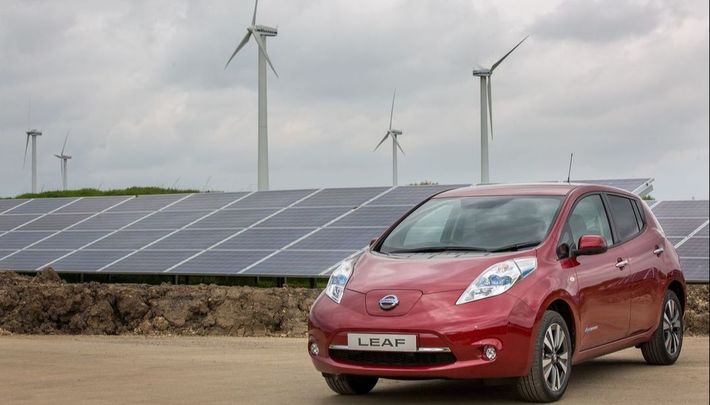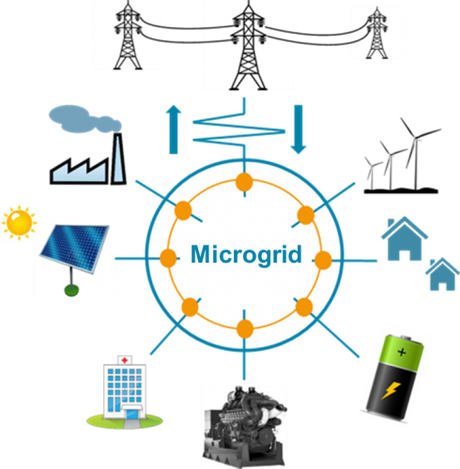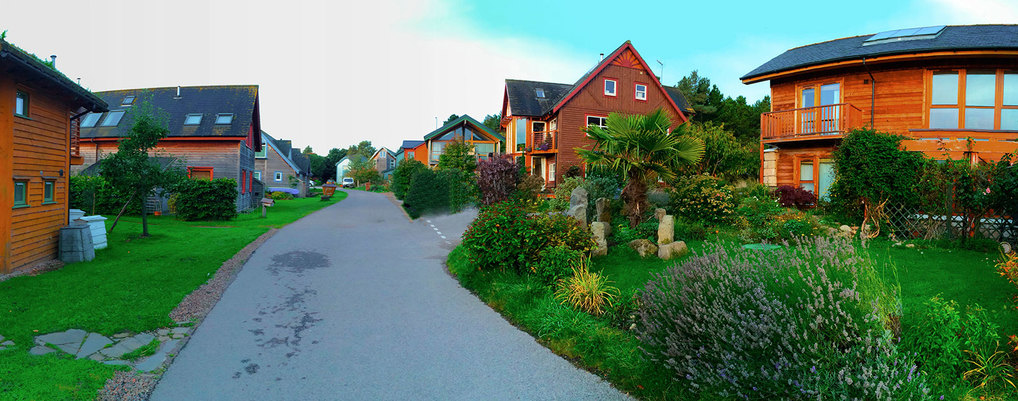Transportation and Electric Vehicles
Transportation is one of the most important factors that affect the total energy consumption. Specifically, in the UK the sector of transport accounts for 40% of the total energy consumption [4]. This parameter plays also a significant role in the pollution of the environment because the majority of the vehicles release carbon emissions. Furthermore, many governments and nations implement various laws and policies in order to reduce the greenhouse emissions. Some of these policies concern the adoption of electric vehicles (EVs) which are under the spotlight and their utilization is constantly increasing. By May 2018 in UK, their number increased to more than 150,000 and the number of charging points to more than 4,300 [8]. Moreover, the government offers financial benefits (incentives) through tax credits, subsidies and grants, depending on the characteristics of the vehicle, to the customers in order to encourage their adoption.
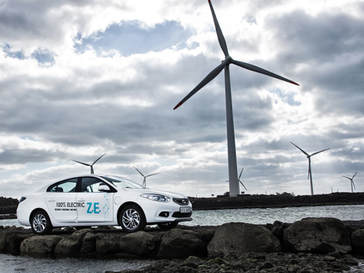
Renewable energy sources and EVs decrease the carbon emissions from both the power generation and transportation sectors. Despite the beneficial impacts that EVs have on the environment as they produce no emissions, decrease the reliance on petroleum and improve the ambient air quality, as well as, the contribution to the integration of renewable energy systems into the current electricity grid, they also have massive implications for the grid (especially in high percentages of EV adoption) [1]. By implementing the EV adoption the demand is increasing, so the grid might not be able to support this increase, thus more generation and storage will be needed [9]. Furthermore, in uncontrolled charging scenarios the charging during peak demands occurs and there is a risk of overloading the transformers. On the other hand EVs can have a positive role and stabilize the grid as they can be used a mobile battery [7].
Decentralization
|
Another highly debatable topic is the decentralized energy, which is the energy generated close to where it will be used (off the main grid). Many support that decentralization of energy is the key factor in order to have a more sustainable and environmental-friendly electricity system. Through small-capacity units which are connected to the power grid, renewable energy sources produce energy and distribute it at a local scale [2]. Nowadays, more and more micro-grids are appearing in order to compliment the main grid and their advantages are obvious. They reduce the transmission losses and the carbon emissions and they increase the security of the customer’s supply. There are also some financial benefits, because they have more stable/better prices than traditional energy. So, micro-grids are considered to be a cost-effective solution to achieve CO2 emission targets in the building sector [3].
|
Ecovillages and their Concept
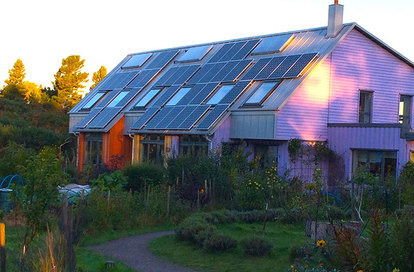
One major priority of these communities is the protection of the environment and their design and development is based on this idea. Thus, ecovillages are very positive towards the installation and the utilization of renewable energy sources in order to cover their energy demands and rely less on fossil fuels and many of them possess their own private electricity grid. Furthermore, over the last years many of these communities tend to electrify, as much as possible, their transportation through the implementation of electric vehicles. By this way, they reduce more their carbon footprint and they achieve a more sustainable way of life which is their main goal. Due to the greenhouse emissions and the pollution of the environment from fossil fuels, governments are turning to the installation of renewable energy systems and they offer grants and subsidies and many ecovillages make use of this situation in order to acquire those systems.
Findhorn Ecovillage
The Findhorn Ecovillage is located at The Park in the south side of the Findhorn village in Moray, Scotland. The population of the community is around 500 residents with 184 households and 61 of them are ecological buildings. The wind farm consists of 4 wind turbines with a total capacity of 750kW which supply more than 100% of the ecovillage’s electricity demand. Specifically, there is a V17 Vestas wind turbine with 75kW capacity and 3 V29 Vestas wind turbines, each one with 225kW capacity and the Community has its own private electricity grid. When the supply exceeds the demand the surplus is exported to the grid. Additionally, there are 25kW of solar- PV installations. Moreover, the Ecovillage has a 250kW biomass boiler providing low-cost heat to some of its buildings. The aim of the Community is to increase the proportion of its energy needs generated from renewable energy sources and remain net exporter of electricity [6].

Findhorn was partner in a research program funded by EU alongside with Strathclyde University, named ORIGIN. The purpose of this project was to optimise the energy generated from the local renewable sources in order to provide the residents information and recommendations on the availability and utilisation of this energy [5]. This optimisation achieved through the collection and monitoring of data about community’s buildings energy requirements and weather situation, which were also used for other projects related to the Ecovillage alongside ours.
References
1]. B.Richardson, D., 2013. Electric vehicles and the electric grid: A review of modeling approaches, Impacts, and renewable energy integration. Renewable and Sustainable Energy Reviews, Volume 19, pp. 247-254.
[2]. CARBON TRUST, 2018. Decentralised energy: powering a sustainable future. [Online]
Available at: https://www.carbontrust.com/news/2013/01/decentralised-energy-powering-a-sustainable-future/ [Accessed 8 May 2018].
[3]. decentralized energy, 2018. Benefits of decentralized energy can be enjoyed by all. [Online]
Available at: http://www.decentralized-energy.com/index/about-us.html [Accessed 9 May 2018].
[4]. Department for Bussiness, Energy & Industrial Strategy, 2017. Energy Trends, London: National Statistics.
[5]. Findhorn College, 2014. ORIGIN CONCEPT. [Online]
Available at: https://www.findhorncollege.org/origin.php [Accessed 9 May 2018].
[6]. Findhorn Ecovillage, 2017. Renewable Energy Systems. [Online]
Available at: https://www.ecovillagefindhorn.com/[Accessed 15 April 2018].
[7]. fleet.carma, 2018. The impact of growing electric vehicle adoption on electric utility grids. [Online]
Available at: https://www.fleetcarma.com/impact-growing-electric-vehicle-adoption-electric-utility-grids/ [Accessed 8 May 2018].
[8]. next greencar, 2018. Electric car market statistics. [Online]
Available at: http://www.nextgreencar.com/electric-cars/statistics/ [Accessed 8 May 2018].
[9]. R&D, 2018. Electric Vehicles could impact the Grid. [Online]
Available at: https://www.rdmag.com/article/2018/01/electric-vehicles-could-impact-grid [Accessed 8 May 2018].
[2]. CARBON TRUST, 2018. Decentralised energy: powering a sustainable future. [Online]
Available at: https://www.carbontrust.com/news/2013/01/decentralised-energy-powering-a-sustainable-future/ [Accessed 8 May 2018].
[3]. decentralized energy, 2018. Benefits of decentralized energy can be enjoyed by all. [Online]
Available at: http://www.decentralized-energy.com/index/about-us.html [Accessed 9 May 2018].
[4]. Department for Bussiness, Energy & Industrial Strategy, 2017. Energy Trends, London: National Statistics.
[5]. Findhorn College, 2014. ORIGIN CONCEPT. [Online]
Available at: https://www.findhorncollege.org/origin.php [Accessed 9 May 2018].
[6]. Findhorn Ecovillage, 2017. Renewable Energy Systems. [Online]
Available at: https://www.ecovillagefindhorn.com/[Accessed 15 April 2018].
[7]. fleet.carma, 2018. The impact of growing electric vehicle adoption on electric utility grids. [Online]
Available at: https://www.fleetcarma.com/impact-growing-electric-vehicle-adoption-electric-utility-grids/ [Accessed 8 May 2018].
[8]. next greencar, 2018. Electric car market statistics. [Online]
Available at: http://www.nextgreencar.com/electric-cars/statistics/ [Accessed 8 May 2018].
[9]. R&D, 2018. Electric Vehicles could impact the Grid. [Online]
Available at: https://www.rdmag.com/article/2018/01/electric-vehicles-could-impact-grid [Accessed 8 May 2018].

UNIVERSITY OF STRATHCLYDE
Address:
16 Richmond St
Glasgow G1 1XQ
United Kingdom
Phone:
+ 44 141 552 4400
Address:
16 Richmond St
Glasgow G1 1XQ
United Kingdom
Phone:
+ 44 141 552 4400

